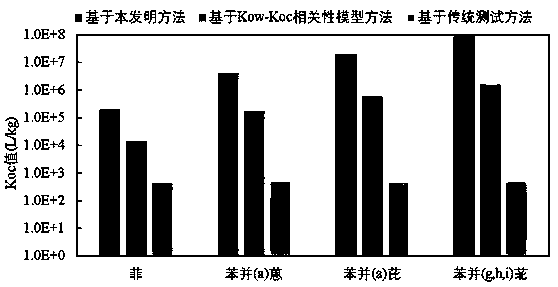Method for detecting organic carbon-water distribution coefficient of aromatic hydrocarbon in actual soil
A technology of distribution coefficient and organic carbon, which is applied in the field of environmental risk assessment and measurement, can solve the problems of unsuitable highly hydrophobic organic compounds, underestimation of Koc value, and large model fluctuations, etc., and achieves simple and easy calculation methods, direct methods, and easy access Effect
- Summary
- Abstract
- Description
- Claims
- Application Information
AI Technical Summary
Problems solved by technology
Method used
Image
Examples
Embodiment 1
[0037] Embodiment 1: a method for measuring the organic carbon-water partition coefficient of aromatic hydrocarbons in actual soil, comprising the following steps:
[0038] S1. Collect the soil polluted by aromatic hydrocarbons, put the contaminated soil sample in a cool place to air dry, remove impurities such as plant roots and gravel, crush it and pass it through a 100-200 mesh sieve, put it in a ziplock bag and place it at 4 °C Store in dark environment;
[0039] S2. Weighing a certain amount of contaminated soil treated in S1, and measuring the concentration of aromatic hydrocarbons (Cs) in the soil;
[0040] S3. Weighing a certain amount of contaminated soil treated in S1, and measuring the soil organic carbon content (foc);
[0041] S4. Take out the disposable polydimethylsiloxane fiber (passive sampler) and cut it into 2-5cm long fiber segments. Soak the fiber segment in methanol solution for 24-25h. Ultrasonic cleaning with deionized water 2-3 times, 10-20min each t...
Embodiment 2
[0061] Embodiment 2: Based on Embodiment 1, the difference is that the soil polluted by phenanthrene is collected, and the contaminated soil sample is placed in a cool place for air-drying and crushing. After crushing, it is passed through a 150-mesh sieve for subsequent use. After the polluted soil, measure the concentration of phenanthrene in the soil (Cs) and the content of phenanthrene organic carbon in the soil (foc), take out the disposable polydimethylsiloxane fiber (passive sampler), and cut into 3cm long fiber segments , soak the fiber segment in methanol solution for 24 hours, after soaking, ultrasonically clean it with sterilized deionized water for 3 times, each time for 15 minutes, dry it for later use, use a 25mL brown chromatographic bottle as the reaction vessel, and weigh 5g of it for treatment The final contaminated soil is placed in the reaction container, and an appropriate amount of sterilized deionized water is added according to the solid-liquid ratio of ...
Embodiment 3
[0063] Embodiment 3: Based on Examples 1 and 2, the difference is that the soil polluted by benzo(a)anthracene is collected, and the contaminated soil sample is air-dried and pulverized, and then passed through a 100-mesh sieve for subsequent use. Amount of contaminated soil after treatment, measure the concentration (Cs) of benzo(a) anthracene in the soil and the organic carbon content (foc) of benzo(a) anthracene in the soil, take out the disposable polydimethylsiloxane fiber ( Passive sampler), and cut into 2cm fiber segments, soak the fiber segments in methanol solution for 24h, after soaking, use sterilized deionized water to ultrasonically clean twice, each time for 10min, dry and set aside, use 20mL The brown chromatographic bottle was used as the reaction vessel, and 2g of the treated contaminated soil was weighed and placed in the reaction vessel, and an appropriate amount of sterilized deionized water was added according to the solid-to-liquid ratio of 1:3 to form a s...
PUM
| Property | Measurement | Unit |
|---|---|---|
| diameter | aaaaa | aaaaa |
| thickness | aaaaa | aaaaa |
Abstract
Description
Claims
Application Information
 Login to View More
Login to View More - R&D
- Intellectual Property
- Life Sciences
- Materials
- Tech Scout
- Unparalleled Data Quality
- Higher Quality Content
- 60% Fewer Hallucinations
Browse by: Latest US Patents, China's latest patents, Technical Efficacy Thesaurus, Application Domain, Technology Topic, Popular Technical Reports.
© 2025 PatSnap. All rights reserved.Legal|Privacy policy|Modern Slavery Act Transparency Statement|Sitemap|About US| Contact US: help@patsnap.com



